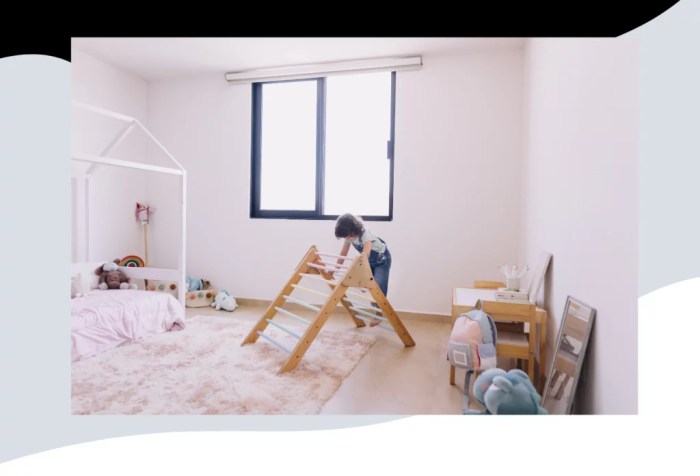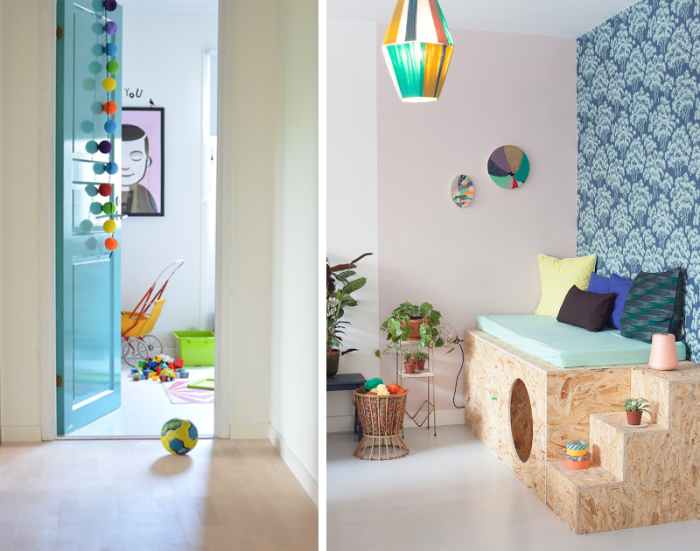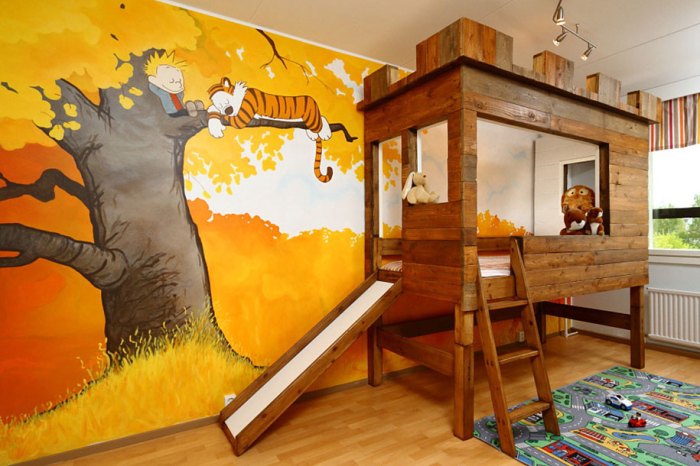Transforming a child’s room into a haven of both fun and functionality requires careful planning and creative vision. This guide explores the key elements involved in designing a space that fosters creativity, learning, and restful sleep. We’ll delve into space planning, color palettes, the creation of distinct play zones, and the selection of age-appropriate and durable furniture, all while prioritizing safety and a stimulating environment.
From choosing the perfect color scheme to incorporating interactive learning elements, we’ll provide practical advice and inspiring ideas to help you create a room that reflects your child’s unique personality and developmental needs. The ultimate goal is to design a space where children can thrive, learn, and play, creating lasting positive memories.
Space Planning and Furniture Selection

Effective space planning and furniture selection are crucial for creating a children’s room that is both playful and functional. Careful consideration of the child’s age, needs, and the available space will ensure a comfortable and stimulating environment that promotes both imaginative play and organized living. This section will explore practical strategies for maximizing space efficiency and selecting appropriate furniture.
Space Planning using a Responsive HTML Table
A well-designed layout maximizes space and functionality. The following table illustrates three potential furniture arrangements for a child’s room, adaptable to different room sizes and shapes. Remember to consider the room’s natural light and placement of doors and windows when planning.
| Arrangement | Description | Pros | Cons |
|---|---|---|---|
| Arrangement 1: Classic Layout | Bed against one wall, desk opposite, wardrobe on another wall. Play area in the remaining space. | Simple, straightforward, good for smaller rooms. | May feel cramped if the room is small; limited play space. |
| Arrangement 2: L-Shaped Layout | Desk and wardrobe arranged in an L-shape, creating a defined study/storage area. Bed and play area in the remaining space. | Efficient use of corner space, creates distinct zones. | Might not suit all room shapes, requires careful measurement. |
| Arrangement 3: Multi-functional Layout | Loft bed with desk or storage underneath, freeing up floor space for play. Wardrobe against a wall. | Maximizes floor space, ideal for smaller rooms. | Loft beds may not be suitable for very young children due to safety concerns. |
Three Distinct Furniture Sets for a Children’s Room
Choosing the right furniture set significantly impacts the room’s overall aesthetic and functionality. Below are descriptions of three distinct sets, each catering to different needs and styles.
Set 1: The Classic Set: This set typically includes a single bed, a wardrobe with ample storage, and a simple desk and chair. It’s characterized by its practicality and timeless appeal. The benefits are its simplicity and affordability. However, it may lack features to encourage creative play.
Set 2: The Playful Set: This set might include a themed bed (e.g., a car bed or a castle bed), colorful storage units, and a play table with chairs. It prioritizes fun and imaginative play. The benefits include a stimulating environment and engagement with creative play. However, it may require more space and might not be as versatile as the classic set.
Set 3: The Multi-functional Set: This set incorporates space-saving features such as a loft bed with built-in storage or a trundle bed. It often includes modular storage units that can be adapted as the child grows. The benefits include maximizing space and adaptability to changing needs. However, it may be more expensive than other options.
Essential Storage Solutions for a Children’s Room
Effective storage is key to maintaining a tidy and organized environment. The following storage solutions are essential for a child’s room:
A well-organized storage system helps children develop good habits from a young age, promoting independence and responsibility. The following list details five key storage components.
- Wardrobe: For clothing and larger items.
- Drawers: For smaller items like toys, books, and stationery.
- Shelves: For books, toys, and decorative items; easy access for children.
- Toy bins/baskets: For easy organization and cleanup of toys.
- Under-bed storage: Maximizes space utilization and keeps items out of sight.
Choosing Age-Appropriate and Safe Furniture
Selecting age-appropriate furniture ensures safety and promotes the child’s development. The following steps are crucial when choosing furniture:
- Consider the child’s age and developmental stage: Choose furniture suitable for their size and abilities. For example, avoid high beds for toddlers.
- Prioritize safety features: Look for furniture with rounded edges and stable construction to minimize the risk of injury. Avoid furniture with small parts that could be choking hazards.
- Check for durability and quality: Invest in sturdy furniture that can withstand wear and tear. Look for materials that are easy to clean and maintain.
- Choose age-appropriate designs and colors: Select furniture that appeals to the child’s interests and age. Bright colors and playful designs are often appealing to younger children.
- Consider future needs: Choose furniture that can adapt to the child’s changing needs as they grow older. Modular furniture or adaptable designs are beneficial in this regard.
Color Palette and Decor

Creating a visually appealing and stimulating environment for a child’s room involves careful consideration of color palettes and decorative elements. The right combination can foster creativity, relaxation, and a sense of wonder. This section will explore various color schemes and decorative ideas to achieve a playful and functional space.
Three Playful Color Palettes
Three distinct color palettes are presented below, each designed to evoke a unique and engaging theme for a child’s room. These palettes consider the psychological impact of color on children’s development and well-being.
- Ocean Adventure: This palette uses calming blues and greens, accented with bright coral and sandy beige. The serene blues promote relaxation and tranquility, while the greens symbolize nature and growth. Coral adds a playful pop of energy, representing the vibrancy of underwater life, and beige provides a grounding neutral tone. The emotional impact is one of calm adventure and peaceful exploration. Imagine a room with walls painted a soft teal, coral-colored accents on furniture, and beige bedding.
- Whimsical Forest: This palette features earthy greens and browns, combined with playful pops of yellow and orange. The deep greens and browns create a sense of security and grounding, representing the natural world. Yellow and orange add brightness and warmth, symbolizing sunshine and energy, stimulating creativity and imagination. The overall emotional impact is one of warmth, comfort, and playful exploration within a safe and natural environment. Think of moss green walls, warm brown furniture, and yellow and orange accents in textiles and artwork.
- Outer Space: This palette utilizes deep blues and purples, accented with silver and bright nebulas of pink and orange. The dark blues and purples evoke the mystery and wonder of the cosmos. Silver adds a futuristic, sleek touch, while the pops of pink and orange represent the vibrant colors of distant planets and stars. This palette fosters curiosity and a sense of adventure. The emotional impact is one of wonder, exploration, and a sense of limitless possibility. Imagine a dark blue wall with glowing star stickers, silver furniture accents, and colorful nebula-inspired textiles.
Playful Decorative Elements
The addition of playful decorative elements significantly enhances the aesthetic appeal and functionality of a child’s room. These elements should be both visually stimulating and practical.
- Interactive Wall Decals: These decals can be used to create a personalized and engaging environment. For instance, a world map with removable stickers allows for imaginative travel adventures. The contribution is enhanced interactivity and learning.
- Colorful Rugs: Rugs define spaces within the room and add warmth and texture. A vibrant rug with playful patterns can become a focal point for play and relaxation. This contributes to comfort and visual appeal.
- Soft, Textured Throw Pillows and Blankets: These add comfort and visual interest, creating a cozy and inviting atmosphere. The tactile nature encourages sensory exploration and relaxation. The contribution is comfort and sensory stimulation.
- Floating Shelves: These provide storage and display space, perfect for showcasing toys, books, and artwork. The contribution is both functionality and display space.
- A Canopy Bed or Tent: This creates a magical and private space for imaginative play and relaxation. The contribution is a sense of privacy and a whimsical play area.
Wall Art and Creative Displays
Wall art and creative displays are essential in stimulating a child’s imagination and creativity. The following Artikels a plan for incorporating these elements.
Wall art can range from hand-painted murals depicting favorite characters or scenes from nature, to framed prints of child-friendly art. Creative displays can include corkboards for displaying artwork, magnetic boards for imaginative play, or even a dedicated gallery wall showcasing the child’s creations. Materials could include paints, crayons, markers, construction paper, fabric scraps, and found objects. Techniques might include painting, drawing, collage, and mixed media. The overall effect should be a dynamic and ever-evolving display that reflects the child’s interests and growth.
Lighting to Create Moods and Ambiances
Lighting plays a crucial role in setting the mood and ambiance of a child’s room. Different types of lighting can be strategically placed to create various atmospheres.
A combination of ambient, task, and accent lighting is ideal. Ambient lighting, such as a ceiling fixture or wall sconces, provides overall illumination. Task lighting, like a desk lamp or bedside lamp, focuses light on specific areas for activities like reading or drawing. Accent lighting, such as fairy lights or string lights, adds a whimsical touch and can highlight decorative elements. Placement should be carefully considered to avoid harsh shadows and ensure adequate lighting for all activities. Dimmers can be incorporated to control the intensity and create different moods throughout the day.
Play and Learning Zones

Creating distinct play zones within a child’s room fosters their development and caters to their diverse interests. By designating specific areas for different activities, you encourage focused play and learning, promoting a sense of order and organization. This approach helps children transition smoothly between activities and promotes a healthy balance between active and quiet pursuits.
Three Distinct Play Zones
Designing three distinct play zones—one for creative play, another for quiet reading, and a third for active play—offers a balanced environment supporting diverse developmental needs. Each zone should be thoughtfully designed to maximize its functionality and appeal to the child’s age and interests.
- Creative Play Zone: This area could feature a large art table with ample storage for crayons, paints, and art supplies. A chalkboard wall or large roll of paper encourages free expression. Soft, washable rugs protect the floor and provide a comfortable workspace. Consider including a dedicated area for building blocks or LEGOs, perhaps with shelving to organize the pieces. A low, sturdy table and chairs are ideal for younger children.
- Quiet Reading Zone: A cozy reading nook is crucial for fostering a love of books. This could involve a comfortable armchair or beanbag chair, positioned near a window for natural light. Soft lighting, such as a small table lamp, creates a calming ambiance. Shelving filled with age-appropriate books is essential. A small rug adds warmth and visual appeal. Consider including a cushion or blanket for extra comfort.
- Active Play Zone: This zone should accommodate movement and physical activity. A small play tunnel, a climbing structure (age-appropriate), or even just ample floor space for crawling and playing with toys will work. Soft, durable flooring is recommended to cushion falls. Storage solutions for balls, sports equipment, and other active play items are important. A mirror could be incorporated to encourage imaginative play.
Interactive Learning Elements
Interactive elements significantly enhance a child’s learning experience, transforming their room into an engaging and educational space. These elements stimulate curiosity and encourage exploration, promoting cognitive development and problem-solving skills.
- Magnetic Alphabet Tiles: These tiles allow children to experiment with letter recognition and spelling, promoting early literacy skills. The magnetic surface allows for creative play on a refrigerator or magnetic board.
- Building Blocks: Blocks encourage spatial reasoning, problem-solving, and fine motor skill development. They offer endless possibilities for creative construction and imaginative play.
- Interactive Globe: A globe with interactive features, such as lights and sounds, introduces children to geography and different cultures. It stimulates their curiosity about the world and fosters a sense of global awareness.
- Number Puzzles: These puzzles help children learn numbers, counting, and basic arithmetic in a fun and engaging way. They develop problem-solving skills and hand-eye coordination.
- Play-Doh or Clay: Working with play-doh or clay improves fine motor skills, hand-eye coordination, and creativity. Children can express themselves through sculpting and creating different shapes and objects.
Dedicated Reading Nook Design
A dedicated reading nook is essential for cultivating a love of books. This space should be inviting, comfortable, and stimulating. The design should consider the child’s age and preferences, prioritizing comfort and accessibility.
A small, comfortable armchair or a beanbag chair is ideal. Soft lighting, provided by a small table lamp with a warm light, creates a relaxing atmosphere. A small, colorful rug defines the space and adds warmth. Open shelving within reach displays a curated selection of age-appropriate books, encouraging browsing and selection. The walls could be decorated with colorful book-themed wall art or a removable wallpaper with a playful design.
Functional Workspace Design
A dedicated workspace supports homework completion and creative projects. Ergonomics and organization are crucial for promoting good posture and efficient workflow. The workspace should be age-appropriate and adaptable as the child grows.
A child-sized desk and chair, adjustable in height, ensure proper posture. Storage solutions, such as drawers, shelves, and organizers, keep materials tidy. Good lighting, both natural and artificial, minimizes eye strain. A corkboard or whiteboard provides a space for notes and artwork. Consider incorporating a comfortable footrest to support proper posture during longer work sessions. The color scheme should be calming and inspiring.
End of Discussion

Designing a playful and functional children’s room is a rewarding endeavor, resulting in a space that nurtures a child’s growth and development. By thoughtfully considering space planning, color palettes, play zones, and learning elements, you can create a vibrant and stimulating environment that supports your child’s unique needs and fosters their imagination. Remember that the process is as important as the outcome, allowing for flexibility and adaptation as your child grows and changes.